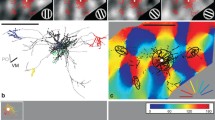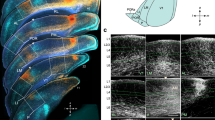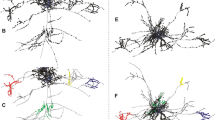Abstract
At the transition from early reptilian ancestors to primordial mammals, the areas of sensory cortex that process topographic modalities acquire the laminar structure of isocortex. A prominent step in lamination is granulation, whereby the formerly unique principal layer of pyramidal cells is split by the insertion of a new layer of excitatory, but intrinsic, granule cells, layer IV. I consider the hypothesis that granulation, and the differentiation between supra- and infra-granular pyramidal layers, may be advantageous to support fine topography in their sensory maps. Fine topography implies a generic distinction between “where” information, explicitly mapped on the cortical sheet, and “what” information, represented in a distributed fashion as a distinct firing pattern across neurons. These patterns can be stored on recurrent collaterals in the cortex, and such memory can help substantially in the analysis of current sensory input. The simulation of a simplified network model demonstrates that a non-laminated patch of cortex must compromise between transmitting “where” information or retrieving “what” information. The simulation of a modified model including differentiation of a granular layer shows a modest but significant quantitative advantage, expressed as a less severe trade-off between “what” and “where”. The further connectivity differentiation between infra-granular and supra-granular pyramidal layers is shown to match the mix of “what” and “where” information optimal for their respective target structures.
Similar content being viewed by others
References
Abeles M (1991) Corticonics: Neural Circuits of the Cerebral Cortex. Cambridge University Press, Cambridge.
Allen KM, Walsh CA (1999) Genes that regulate neuronal migration in the cerebral cortex. Epilepsy Res. 36: 143-154.
Allman J (1990) Evolution of neocortex. In: EG Jones, A Peters, eds. Cerebral Cortex, Vol. 8A: Comparative Structure and Evolution of Cerebral Cortex. Plenum Press, New York. pp. 269-283.
Amit DJ (1989) Modelling Brain Function. Cambridge University Press, Cambridge.
Amit DJ (1995) The Hebbian paradigm reintegrated: Local reverberations as internal representations. Behav. Brain Sci. 18: 617-657.
Bar I, Goffinet AM (2000) Evolution of cortical lamination: The reelin/Dab1 pathway. Novartis Found. Symp. 228: 114-128.
Barbas H, Rempel-Clower N (1997) Cortical structure predicts the pattern of cortico-cortical connections. Cereb. Cortex 7: 635-646.
Batardiere A, Barone P, Dehay C, Kennedy H (1998) Area-specific laminar distribution of cortical feedback neurons projecting to cat area 17: Quantitative analysis in the adult and during ontogeny. J. Comp. Neurol. 396: 493-510.
Bosking WH, Crowley JC, Fitzpatrick D (2002) Spatial coding of position and orientation in primary visual cortex. Nature Neurosci. 5: 874-882.
Bosking WH, Zhang Y, Schofield B, Fitzpatrick D (1997) Orientation selectivity and the arrangement of horizontal connections in tree shrew striate cortex. J. Neurosci. 17: 2112-2127.
Braitenberg V, Schuez A (1991) Anatomy of the Cortex. Springer-Verlag, Berlin.
Carroll RL (1997) Patterns and Processes of Vertebrate Evolution. Cambridge University Press, Cambridge.
Creutzfeldt OD (1977) Generality of the functional structure of the neocortex. Naturwissenschaften 64: 507-517.
Diamond IT, Hall WC (1969) Evolution of neocortex. Science 164: 251-262.
Douglas RJ, Martin KAC, Whitteridge D (1989) A canonical microcircuit for neocortex. Neural Comput. 1: 480-488.
Erickson RP, Hall WC, Jane JA, Snyder M, Diamond IT (1967) Organization of the posterior dorsal thalamus of the hedgehog. J. Comp. Neurol. 131: 103-130.
Feldmeyer D, Egger V, Lubke J, Sakmann B (1999) Reliable synaptic connections between pairs of excitatory layer 4 neurones within a single ‘barrel’ of developing rat somatosensory cortex. J. Physiol. 521: 169-190.
Felleman DJ, Van Essen DC (1991) Distributed hierarchical processing in the primate cerebral cortex. Cerebral Cortex 1: 1-47.
Grossberg S (1999) How does the cerebral cortex work? Learning, attention, and grouping by the laminar circuits of visual cortex. Spat. Vis. 12: 163-185.
Haberly LB (1990) Comparative aspects of olfactory cortex. In: EG Jones, A Peters, eds. Cerebral Cortex,Vol. 8B: Comparative Structure and Evolution of Cerebral Cortex. Plenum Press, New York. pp. 137-166.
Hennig MH, Kerscher N, Funke K, Woergoetter F (2001) Stochastic resonance in the visual system: Does the eye-tremor actually improve visual acuity? Soc. Neurosci. Abs. 821.29.
Hopfield JJ (1982) Neural networks and physical systems with emergent collective computational capabilities. Proc. Natl. Acad. Sci. USA 79: 2554-2558.
Gloor P (1997) The Temporal Lobe and Limbic System. Oxford University Press, New York.
Innocenti GM (1986) General organization of callosal connections in the cerebral cortex. In: EG Jones, A Peters, eds. Cerebral Cortex, Vol. 5: Sensory-Motor Areas and Aspects of Cortical Connectivity. Plenum Press, New York. pp. 291-353.
Jones EG (1998) Viewpoint: The core and matrix of thalamic organization. Neuroscience. 85: 331-345.
Kaas JH (1993) Evolution of multiple areas and modules within neocortex. Perspect. Dev. Neurobiol. 1: 101-107.
Kayser AS, Miller KD (2002) Opponent inhibition:Adevelopmental model of layer 4 of the neocortical circuit. Neuron. 33: 131-142.
Krubitzer L (1995) The organization of neocortex in mammals: Are species differences really so different? Trends Neurosci. 18: 408-417.
Lassalle J-M, Bataille T, Halley H (2000) Reversible inactivation of the hippocampal mossy fiber synapses in mice impairs spatial learning, but neither consolidation nor memory retrieval, in the Morris navigation task. Neurobiol. Lear. Mem. 73: 243-257.
Lubke J, Egger V, Sakmann B, Feldmeyer D (2000) Columnar organization of dendrites and axons of single and synaptically coupled excitatory spiny neurons in layer 4 of the rat barrel cortex. J. Neurosci. 20: 5300-5311.
Marr D (1971) Simple memory:Atheory for archicortex. Phil. Trans. R. Soc. Lond. B 262: 24-81.
McComas AJ, Cupido CM (1999) The Ruler model. Is this how the somatosensory cortex works? Clin. Neurophysiol. 110: 1987-1994.
Meffin H (2000) Ph.D. Thesis, University of Sidney, Department of Mathematics.
Nicoll A, Blakemore C (1993) Patterns of local connectivity in the neocortex. Neural Comput. 5: 665-680.
Noctor SC, Palmer SL, McLaughlin DF, Juliano SL (2001) Disruption of layers 3 and 4 during development results in altered thalamocortical projections in ferret somatosensory cortex. J. Neurosci. 21: 3184-3195.
Podlogar M, Dietrich D, Selke K, Kral T, Clusmann H, Schramm J (2001) Perforated patch-analysis of firing properties in hippocampal granule cells: Minimal sAHP and tonic firing. Soc Neurosci abs. 37.3.
Rauschecker JP, Tian B, Hauser M (1995) Processing of complex sounds in the macaque nonprimary auditory cortex. Science 268: 111-114.
Rockel AJ, Hiorns RW, Powell TBS (1980) The basic uniformity in structure of the neocortex. Brain 103: 221-244.
Rolls ET, Treves A (1998) Neural Networks and Brain Function. Oxford University Press, Oxford.
Rowe M (1990) Organization of the cerebral cortex in monotremes and marsupials. In: EG Jones, A Peters, eds. Cerebral Cortex, Vol. 8B: Comparative Structure and Evolution of Cerebral Cortex. Plenum Press, New York. pp. 263-334.
Super H, Uylings HBM (2001) The early differentiation of the neocortex: Ahypothesis on neocortical evolution. Cerebral Cortex 11: 1101-1109.
Szentagothai J (1978) The neuron network of the cerebral cortex: A functional interpretation. Proc. Roy. Soc. (London) B 201: 219-248.
Tarczy-Hornoch K, Martin KA, Stratford KJ, Jack JJ (1999) Intracortical excitation of spiny neurons in layer 4 of cat striate cortex in vitro. Cereb Cortex 9: 833-843.
Thorpe SJ, Imbert M (1989) Biological constraints on connectionist models. In: R Pfeifer, Z Schreter, F Fogelman-Soulie, eds. Connectionism in Perspective. Elsevier, Amsterdam. pp. 63-92.
Treves A (1993) Local neocortical processing: A time for recognition. Int. J. Neural. Syst. 3: 115-119.
Treves A (2001) Information coding in higher sensory and memory areas. In: F Moss, S Gielen, eds. Handbook of Biological Physics, Vol. 4: Neuro-Informatics and Neural Modelling. Elsevier. Amsterdam. pp. 825-852.
Treves A, Rolls ET (1992) Computational constraints suggest the need for two distinct input systems to the hippocampal CA3 network. Hippocampus 2: 189-199.
Treves A, Samengo I (2002) Standing on the gateway to memory: Shouldn’t we step in? Cognitive Neuropsychology 12: 557-575.
Ulinski PS (1990) The cerebral cortex of reptiles. In: EG Jones, A Peters, eds. Cerebral Cortex, Vol. 8A: Comparative Structure and Evolution of Cerebral Cortex. Plenum Press, New York. pp. 139-215.
Welker C (1971) Microelectrode delineation of fine grain somatotopic organization of (SmI) cerebral neocortex in albino rat. Brain Res. 26: 259-275.
Whitfield IC (1979) The object of the sensory cortex. Brain Behav. Evol. 16: 129-154.
Yoshioka T, Levitt JB, Lund JS (1992) Intrinsic lattice connections of macaque monkey visual cortical area V4. J. Neurosci. 12: 2785-2802.
Zatorre RJ, Bouffard M, Ahad P, Belin P (2002) Where is ‘where’ in the human auditory cortex? Nature Neurosci. 5: 905-909.
Author information
Authors and Affiliations
Rights and permissions
About this article
Cite this article
Treves, A. Computational Constraints that may have Favoured the Lamination of Sensory Cortex. J Comput Neurosci 14, 271–282 (2003). https://doi.org/10.1023/A:1023213010875
Issue Date:
DOI: https://doi.org/10.1023/A:1023213010875




